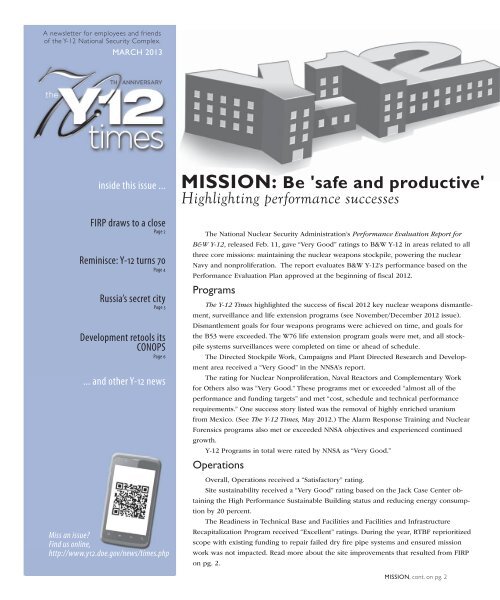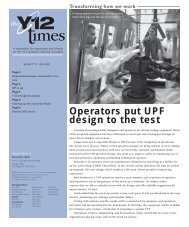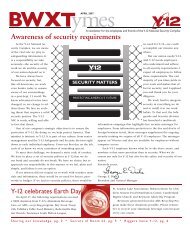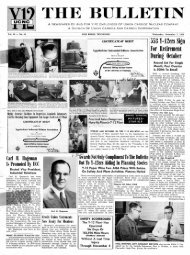March - Y-12 National Security Complex - U.S. Department of Energy
March - Y-12 National Security Complex - U.S. Department of Energy
March - Y-12 National Security Complex - U.S. Department of Energy
You also want an ePaper? Increase the reach of your titles
YUMPU automatically turns print PDFs into web optimized ePapers that Google loves.
A newsletter for employees and friends<strong>of</strong> the Y-<strong>12</strong> <strong>National</strong> <strong>Security</strong> <strong>Complex</strong>.MARCH 2013inside this issue ...FIRP draws to a closePage 2Reminisce: Y-<strong>12</strong> turns 70Page 4Russia’s secret cityPage 5Development retools itsCONOPSPage 6... and other Y-<strong>12</strong> newsMiss an issue?Find us online,http://www.y<strong>12</strong>.doe.gov/news/times.phpMISSION: Be 'safe and productive'Highlighting performance successesThe <strong>National</strong> Nuclear <strong>Security</strong> Administration’s Performance Evaluation Report forB&W Y-<strong>12</strong>, released Feb. 11, gave “Very Good” ratings to B&W Y-<strong>12</strong> in areas related to allthree core missions: maintaining the nuclear weapons stockpile, powering the nuclearNavy and nonproliferation. The report evaluates B&W Y-<strong>12</strong>’s performance based on thePerformance Evaluation Plan approved at the beginning <strong>of</strong> fiscal 20<strong>12</strong>.ProgramsThe Y-<strong>12</strong> Times highlighted the success <strong>of</strong> fiscal 20<strong>12</strong> key nuclear weapons dismantlement,surveillance and life extension programs (see November/December 20<strong>12</strong> issue).Dismantlement goals for four weapons programs were achieved on time, and goals forthe B53 were exceeded. The W76 life extension program goals were met, and all stockpilesystems surveillances were completed on time or ahead <strong>of</strong> schedule.The Directed Stockpile Work, Campaigns and Plant Directed Research and Developmentarea received a “Very Good” in the NNSA’s report.The rating for Nuclear Nonproliferation, Naval Reactors and Complementary Workfor Others also was “Very Good.” These programs met or exceeded “almost all <strong>of</strong> theperformance and funding targets” and met “cost, schedule and technical performancerequirements.” One success story listed was the removal <strong>of</strong> highly enriched uraniumfrom Mexico. (See The Y-<strong>12</strong> Times, May 20<strong>12</strong>.) The Alarm Response Training and NuclearForensics programs also met or exceeded NNSA objectives and experienced continuedgrowth.Y-<strong>12</strong> Programs in total were rated by NNSA as “Very Good.”OperationsOverall, Operations received a “Satisfactory” rating.Site sustainability received a “Very Good” rating based on the Jack Case Center obtainingthe High Performance Sustainable Building status and reducing energy consumptionby 20 percent.The Readiness in Technical Base and Facilities and Facilities and InfrastructureRecapitalization Program received “Excellent” ratings. During the year, RTBF reprioritizedscope with existing funding to repair failed dry fire pipe systems and ensured missionwork was not impacted. Read more about the site improvements that resulted from FIRPon pg. 2.MISSION, cont. on pg. 21
MISSION, cont. from pg. 1Nuclear Materials Control and Accountabilityreceived an “Excellent” having implementedeffective material surveillance, iteminventory and process monitoring programs.The report stated that NMC&A “continues tobe recognized as a leader within theU.S. <strong>Department</strong> <strong>of</strong> <strong>Energy</strong>.”Institutional Management andBusinessThis heading includes general management,business management, informationtechnology and contractor assurance; it wasrated as “Very Good.”Communications “continued to providehigh quality public affairs products insupport <strong>of</strong> the Y-<strong>12</strong> mission.” A Y-<strong>12</strong> MediaCenter was developed for use during emergencypublic communications activities.B&W Y-<strong>12</strong> provided “excellent sustainedsupport for Y-<strong>12</strong> modernization” initiatives,including support for the Stockpile Stewardshipand Management Plan and the EmergencyResponse Facility project.What this meansEach <strong>of</strong> the companies that manageand operate sites for NNSA typically do sounder an award fee structure, which meansthe companies and the government agreeto a potential amount <strong>of</strong> pr<strong>of</strong>it, or fee,which can be earned through demonstratedperformance. In Y-<strong>12</strong>’s instance, the totalavailable fee was a little more than $60 millionin 20<strong>12</strong>; B&W Y-<strong>12</strong> earned 58.9 percent<strong>of</strong> that, or about $35.8 million.President and General Manager ChuckSpencer said, “While these results are not upto our previous standards, it is important torealize that we have made significant progresssince the July 28 event and are <strong>of</strong>f to a verygood start in fiscal year 2013.“As I’ve said before, the best we can dois to perform to the best <strong>of</strong> our abilities everyday, and then go home satisfied that wewere safe and productive. And even thoughwe’re in a time <strong>of</strong> transition related to thecontract bid, it is imperative that we stayfocused on safely and successfully completingour tasks every day.”Site improvements<strong>of</strong> $490 million result from FIRPThe Facilitiesand InfrastructureRecapitalizationProgram has beena key component<strong>of</strong> modernizationand transformationefforts at Y-<strong>12</strong>. Sinceits inception in 2002,FIRP has invested$490 million in facilityand infrastructureupgrades. Theprogram concludedin December withcompletion <strong>of</strong> the finalfacility demolition,Building 9720-18.“FIRP workscope has includedrecapitalization, excessfacility dispositionand utility line-itemThe Potable Water System Upgradesprojects,” said MikeProject and Bear Creek Road PavingProject resulted from the Facilities andRichesin, programInfrastructure Recapitalization Program.manager.Recapitalizationactivities focused on upgrades to mission-essential facilities. One <strong>of</strong> the most notableachievements is the $40 million investment in ro<strong>of</strong> replacements that resulted in28 acres <strong>of</strong> new ro<strong>of</strong>ing.FIRP resources <strong>of</strong> $<strong>12</strong>0 million enabled the demolition <strong>of</strong> 321 excess buildings,reducing the site footprint by 1.4 million square feet and retiring $18 million indeferred maintenance. Facility dispositions at Y-<strong>12</strong> accounted for 47 percent <strong>of</strong> thenuclear security enterprise total square foot reduction goal <strong>of</strong> 3 million square feet.FIRP also sponsored three major utility line-item projects: Compressed AirUpgrades, Potable Water System Upgrades and Steam Plant Life Extension. Thesemodernization projects greatly improved operability and reliability <strong>of</strong> key utilitysystems that serve mission-critical infrastructure.Y-<strong>12</strong> addressed hundreds <strong>of</strong> sitewide infrastructure deficiencies to fulfill the FIRPmission. As the program came to an end, FIRP focused on closeout activities such asremoving abandoned utility poles and cables from demolition sites and refurbishingroadways heavily used during project execution.“Y-<strong>12</strong> has accomplished a huge amount <strong>of</strong> work under FIRP,” Richesin said, “butthere is much work still to be done. We are currently working with headquarters toestablish a new program that will continue infrastructure improvements to ensure Y-<strong>12</strong>missions are accomplished.”2
CONSTRUCTION'hats <strong>of</strong>f' to safetyCongratulations to the Y-<strong>12</strong> Construction team for receiving a secondsignificant safety milestone: zero Occupational Safety and Health Administrationrecordable injuries throughout 20<strong>12</strong>. A recordable injury is anabnormal condition or disorder (such as a cut, burn, sprain or fracture)that must be recorded as required by OSHA. The team was previouslyrecognized for working one million hours without a lost-time accident(see October 20<strong>12</strong>, The Y-<strong>12</strong> Times).“Just 4 months ago, I was here to congratulate you for accomplishingone million hours <strong>of</strong> safe work,” Jim Haynes, senior vice presidentand deputy general manager <strong>of</strong> Projects, said at a celebratory lunch in Construction achieved the one million-hour milestone in August 20<strong>12</strong>,and as <strong>of</strong> January 2013, attained 1.4 million hours (more than 800 days)late January. “It’s an incredible performance by a team that works in awithout a lost-time accident.hazardous environment daily.”Construction Manager Joe Kato told the group, “Today, our performanceis world-class. You believed in yourselves and each other. Hats <strong>of</strong>f to you!”Haynes stressed to the more than 240 Construction workers the importance <strong>of</strong> rememberingthe dangers in their line <strong>of</strong> work, citing OSHA’s “Fatal Four,” the four leading causes<strong>of</strong> worker deaths at construction sites: falls, electrocutions, striking objects and gettingcaught in or between equipment.Kevin Adkisson, president <strong>of</strong> the Knoxville Building and Construction Trades Council,also addressed the group, “I want to congratulate the B&W Y-<strong>12</strong> Construction team on thisunprecedented accomplishment and thank you for your continued collaborative workingrelationship. We remain committed to working safely and watching out for each other.”Haynes challenged the Construction team to take their performance to the next level bymaking a personal commitment to stay focused on safety, watch out for each other, makesafety an uncompromising value and take corrective action when something is wrong —don’t just walk away.Think outside the trash…Recycle!In fiscal 20<strong>12</strong>, Y-<strong>12</strong> recycled more than3 million pounds <strong>of</strong> waste material, theweight <strong>of</strong> some 520 full-size SUVs. Thistotal includes one-time cleanout materialsthat are in addition to routine recyclingitems. Y-<strong>12</strong>’s complex-wide recyclingprogram diverts materials from the landfilland conserves natural resources, ensuringcost-effective operations and environmentalprotection. The list <strong>of</strong> recycled itemsincludes many expected materials likescrap metal, cardboard, plastic and paper.But Y-<strong>12</strong> also recycles things like cookinggrease, lamps, antifreeze and power poles.“DOE sites are requiredto divert from landfills50 percent <strong>of</strong> their solidwaste materials. Recyclingand reusing help us meetthis goal. We close the loopby purchasing materialsand products made fromrecycled items, supportingconservation <strong>of</strong> naturalresources.—Aprell Patterson,Facilities, Infrastructure and Services”3
70 years * 70 years * 70 years * 70 years * 70 years * 70 years * 70 years * 70 years * 70 ye& THEN NOW:Y-<strong>12</strong>’s employee newsletterSeventy years have passed, but you will find similarities between past Y-<strong>12</strong> employee newslettersand today’s The Y-<strong>12</strong> Times. Y-<strong>12</strong> has always been focused on safety: “The Y-<strong>12</strong> Plant hasoperated five days or 89,000 man-hours ...” [The Y-<strong>12</strong> Bulletin, Jan. 3, 1968, pg. 1]. Before westrived to be green, carpooling was a way to get to work: “Will join car pool ...” [The Y-<strong>12</strong> Bulletin,Jan. 3, 1968, pg. 4], and decades before we thought about joining a Y-<strong>12</strong> Employees’ Societysport event, employees participated in outside-<strong>of</strong>-work activities: “Wild and Woolly GamesStaged in Plant Loop,” [The Y-<strong>12</strong> Bulletin, June 3, 1947, pg. 4].The differences are obvious, and it’s interesting to read previous issues [available on theY-<strong>12</strong> website (http://www.y<strong>12</strong>.doe.gov/about/history/historical_media.php)]. We no longerpublish employees’ vacation destinations: “Emil Dittman spent a recent Sunday at Norris Dam,”[The Y-<strong>12</strong> Bulletin, May 25, 1948, pg. 2]. We don’t share news <strong>of</strong> nuptials: “Weddings: Dawson-Brummett” [The Y-<strong>12</strong> Bulletin, Jan. 3, 1968, pg. 4].In the early days, the newsletter was published weekly. Today, the newsletter is publishedmonthly (with a few exceptions when we combine issues), but we have daily news available onour intranet site, YSource, and through e-mail.Below are reflections from several newsletter contributors.Ellen Boatner, Public and Governmental Affairs, former newsletter editor“As the editor <strong>of</strong> the newsletter (back in my day, it covered all three sites), I got to talk witha lot <strong>of</strong> people at Y-<strong>12</strong> about everything from weapons work to building custom birdhouses.I consider Y-<strong>12</strong> my ‘home’ site, and despite the overall coverage <strong>of</strong> the newsletter back then, Ialways considered myself part <strong>of</strong> the Y-<strong>12</strong> family.“That family feeling always was present when you walked around the site because it was(and still is) like living in a small town — everyone knows each other, and if they don’t knowyou, they know someone that does know you.“It has truly moved me to see the outpouring <strong>of</strong> care and concern Y-<strong>12</strong>ers share.”Jill McNutt, Communications Services, newsletter contributor“During the 3 years that I’ve worked at Y-<strong>12</strong>, I’ve found working on The Y-<strong>12</strong> Times to be aunique opportunity, as well as a challenge. Researching and writing articles has given me thechance to learn about Y-<strong>12</strong> from many people across the site. Every day I discover somethingnew about Y-<strong>12</strong>’s missions, history, people and culture, and the Times gives me the medium toshare it.”Donna Watson, Communications Services, newsletter contributor“OPSEC [Operations <strong>Security</strong>] wasn’t the same level <strong>of</strong> concern in the 1940s — or even the1990s — as it is now. Then employees shared personal information without thinking <strong>of</strong> consequences,whereas now, each newsletter is reviewed from an OPSEC perspective in addition toreviews by public affairs, derivative classifiers and the Technical Information Office.”470 years * 70 years * 70 years * 70 years * 70 years * 70 years * 70 years * 70 years * 70 ye
ars * 70 years * 70 years * 70 years * 70 years * 70 years * 70 years * 70 years * 70 yearsLMU honorsOak Ridge connectionFrom left: Chuck Spencer,Y-<strong>12</strong> president and general manager; Ray Smith, Y-<strong>12</strong>historian; Autry O.V. “Pete” DeBusk, DeRoyal Industries; Michelle Branton, U.S.<strong>Department</strong> <strong>of</strong> <strong>Energy</strong>; and Thom Mason, Oak Ridge <strong>National</strong> Laboratory at theunveiling <strong>of</strong> the “Scientists Who Changed the World” exhibit at Lincoln MemorialUniversity. Branton is holding a commemorative plaque given to each <strong>of</strong> the areaDOE sites.AnotherSecret CityFor decades <strong>of</strong>ficial maps did not show Zheleznogorsk, Russia.Created in 1950 to produce weapons-grade plutonium, the Siberian city<strong>of</strong> about 90,000 existed in secrecy until the Cold War’s closein 1991.The end <strong>of</strong> that conflict between the U.S. and the Union <strong>of</strong> SovietSocialist Republics meant the end <strong>of</strong> weapons production, causingthousands <strong>of</strong> highly skilled Russian nuclear workers to lose theirlivelihoods. “As the Russians were reducing the number <strong>of</strong> personnel inthe weapons business, the U.S. didn’t want the workers to be desperatefor jobs,” said Y-<strong>12</strong> Program Manager Ken Williams.Two U.S. <strong>Department</strong> <strong>of</strong> <strong>Energy</strong> programs, Nuclear Cities Initiativesand the Initiatives for Proliferation Prevention, helped Russia’s nuclearworkers move into free enterprise so nuclear materials and expertisewouldn’t be sold to possible terrorists, said Williams, who managed theY-<strong>12</strong> and Oak Ridge <strong>National</strong> Laboratory programs for these initiativesfrom 1999 to 2004. Both programs used DOE funding to start newinitiatives in Russia.Y-<strong>12</strong> and ORNL worked with the Russian government on about15 Nuclear Cities Initiatives projects in Zheleznogorsk and nine otherformerly secret Russian nuclear cities. A company marketing equipmentand providing support services for automated identification technologiesreceived funding, for example, as did businesses producing everythingfrom sunflower oil to refurbished railcar parts.“We brought business to people in places that were open to theoutside for the first time in their lives,” said Williams. “When we came,people were very grateful.”Seventy years ago, construction was under way on what is nowknown as the Y-<strong>12</strong> <strong>National</strong> <strong>Security</strong> <strong>Complex</strong>. To honor work done atY-<strong>12</strong> and other Oak Ridge facilities to support nuclear energy research,Lincoln Memorial University in Harrogate, Tenn., recently installed apermanent display in the university’s Math and Science Building.Y-<strong>12</strong> historian Ray Smith assisted with the design <strong>of</strong> the exhibit, aproject <strong>of</strong> LMU board <strong>of</strong> trustees chair Autry O.V. “Pete” DeBusk.Early in the planning stages for this 140,000–square-foot building,DeBusk knew he wanted to include a display that would inspire futuregenerations <strong>of</strong> LMU scientists, honor visionary leaders whose ideaswere the foundation <strong>of</strong> work done in Oak Ridge and recognize theroles the U.S. <strong>Department</strong> <strong>of</strong> <strong>Energy</strong>, Oak Ridge <strong>National</strong> Laboratoryand Y-<strong>12</strong> have played and continue to play in shaping the LMUcommunity.The “Scientists Who Changed the World” exhibit was unveiledduring the building’s Oct. <strong>12</strong>, 20<strong>12</strong>, dedication and includes a photodisplay and timeline <strong>of</strong> significant events. Governor Bill Haslam servedas the keynote speaker for the dedication ceremony.“When Pete asked me to help recognize the scientific contributionsthat led to the creation <strong>of</strong> Oak Ridge and the substantial resulting economicimpact on East Tennessee, I was honored to help,” Smith said. “Ibelieve that without Oak Ridge we might not have been able to endurethe past 70 years without a World War III and that many scientificdiscoveries and economic development improvements would not havebeen realized.”5ars * 70 years * 70 years * 70 years * 70 years * 70 years * 70 years * 70 years * 70 years
Development improves its CONOPS —and its way <strong>of</strong> doing businessLast October, in a drive to better its Conduct <strong>of</strong> Operationsactivities, Development began submitting its 100 research-anddevelopmentlaboratories to strenuous reorganization and certificationefforts.Development Technology Deployment Manager Bill Rogersonsaid, “We’re not just polishing floors and taking out the papertrash. We’re making up for 50 years <strong>of</strong> ills” — and “changing theway we do business.”“The whole plant has been involved in a CONOPS continuousimprovement program since September 2011, and we used thatas a basis for Development’s action plan,” Development ManagerMark Richey said.A key concept <strong>of</strong> CONOPS is a questioning attitude. Employeesare encouraged to raise questions if some procedure, equipmentor work situation doesn’t seem right.Rogerson said, “People have squirreled away materials — plugins,containers, petri dishes, beakers, hardware, tools gathered forthe past 50 years — and forgotten about them. Getting the materialsout <strong>of</strong> here is difficult because <strong>of</strong> all the waste management,Radiological Control and accountability requirements.”The laboratories will be certified weekly on the basis <strong>of</strong> anewly devised checklist. Section managers will designate a laboratoryperson in charge, who will undergo training and conduct theweekly certification. “The custodians will know who’s doing what,the lab conditions and the safety functions,” Rogerson explained.If any lab does not reach certification standards within six months,the lab will be out <strong>of</strong> commission or placed on restricted activitiesuntil it meets the certification requirements.Development Section Manager Neville Howell, who has ninelabs, said, “… We have RADCON, Industrial Hygiene, Maintenanceand waste management all working hard with us, and they aredoing a great job.”Development’s work control packages also are being reviewedin terms <strong>of</strong> “good hazard analysis, proper documentation andassignment <strong>of</strong> workers who are qualified to perform the tasks,”said Phil Harless, a Development manager. “Work scope andboundaries must be perfectly clear.”From Richey’s perspective, “The biggest thing is that thesechanges will make Development a safer, more efficient and moreaesthetic workplace.”As <strong>of</strong> Feb. 19, the organization has filled 58 B-25 boxes(about 5,500 cubic feet) and 13 sea-land boxes (about16,600 cubic feet) with disposed waste, reportedDevelopment’s key coordinator <strong>of</strong> the plan.6
Around Y-<strong>12</strong> ...• At the University <strong>of</strong> Tennessee Diversity Career Luncheon, Y-<strong>12</strong> Human Resources receivedthe Dr. Jane S. Redmond/PepsiCo Commitment to Diversity Award. Among various sitewideaccomplishments, Human Resources was recognized for Engineering initiatives such asIntroduce a Girl to Engineering, as well as Career ONE minority/female hires. Rachel Carvelland Renee McGhee received the award on behalf <strong>of</strong> Y-<strong>12</strong>.• Kudos to Fire Protection Engineering’s David McAfee who was recently recognized as alifetime member <strong>of</strong> the <strong>National</strong> Fire Protection Association. He’s been an NFPA memberfor 38-plus years, and for more than 20 years, he has been a member <strong>of</strong> the Lightning ProtectionTechnical Committee. “I’ve met a lot <strong>of</strong> good people in the industry and gained insightyou don’t get from reading the codes,” McAfee said.• Congratulations to Y-<strong>12</strong>’s Ralph Honeycutt (left),who received the Ambulance Director <strong>of</strong> theYear Award. Honeycutt didn’t know he would bereceiving the award when he attended the EastTennessee Region II EMS Directors AssociationConference to assist with behind-the-scenesresponsibilities. “We never go as participants; wejust assist with the tasks to help it run smoothly,” hesaid. According to Honeycutt, the award belongs toeveryone involved in getting ALS [Advanced MedicalLife Support] up and running at Y-<strong>12</strong>.• The U.S. Postal Service announced that they willstop delivery <strong>of</strong> letters on Saturdays starting inAugust. Prescription medication shipments areconsidered packages and will continue to bedelivered on Saturdays. Y-<strong>12</strong>’s pharmacy benefitvendor, Express Scripts, will include messagesRalph Honeycuttto this effect on its website and push othercommunication to those covered in the Y-<strong>12</strong>prescription drug plan.• The Pollution Prevention Program sharesthese upcoming events at which you candiscard your unused/unneeded medicinesin an environmentally friendly way. Twoevents are scheduled <strong>March</strong> 23 in Knoxville:Tennova North Medical Center, 7565 DannaherLane, 10 a.m. until 2 p.m. and Walgreens,4001 Chapman Highway, 10 a.m. until 2 p.m.• If you missed WBIR’s look at Y-<strong>12</strong>’s70 years, you can watch the video at thestation’s website (http://www.wbir.com/news/article/255157/2/Y-<strong>12</strong>-celebrates-70-years-). Y-<strong>12</strong> Historian Ray Smith sharessome <strong>of</strong> the site’s unique heritage.• Do you want to spend the July 4 holidayin New York City? If so, visit the Y-<strong>12</strong>Employees’ Society website (available underY in the YSource index) to get the latestinformation about the trip planned forJuly 1–6. Start planning now for thisexciting adventure! Have questions? ContactCharlotte Schaefer (576-8908) or SuzieHousley (576-6365).In memoriamDavid Register <strong>of</strong> QualityAssurance passed awayFeb. 4. He had one year <strong>of</strong>company service.“I did not know David long,but I had time to know that he wassomeone I could call my friend. Hewas a gem,” said co-worker CherylEllis.Co-worker Dan Carnes said,“Although we only got to knowDavid a short time, we could tellthat he was eager to learn the joband to pitch in to help in any wayhe could. I will miss our little daily<strong>of</strong>fice chats.”<strong>March</strong>Service Anniversaries53 yearsChief Financial Officer Division:William R. Ragland45 yearsQuality Assurance: Joseph P. KonopkaStrategic Planning and Transformation:Thomas E. Smith43 yearsProduction: Homer GallaherQuality Assurance: Carl E. Bennett Jr. andWillie T. Thomas42 yearsHuman Resources: Dennis E. BallProjects: Eunice M. Hobbs40 yearsEngineering: Joe G. Arnold and Jerry W.Whittaker35 yearsEngineering: Jeffrey N. PipesEnvironment, Safety and Health: Sherilu D.RowanFacilities, Infrastructure and Services:Shirley A. Hamilton, Michael L. Lovelyand Condy D. SharpProduction: Robert L. StooksburyQuality Assurance: Theresa K. Smith andJerry V. Spence30 yearsEngineering: Patsy A. Crossno and AllenT. WoodsProduction: William A. Cate<strong>Security</strong> and Emergency Services:Patricia L. Johnson25 yearsEngineering: William J. MooreEnvironment, Safety and Health: Beverly J.Shontz and Merritt C. Wiest Jr.Facilities, Infrastructure and Services:Marcus O. PhillipsProgram Management: William S. Allisonand Ronald F. Milligan IIProduction: Michael A. Aloi and Hayes A.Tinker<strong>Security</strong> and Emergency Services:Leonard D. Ervin and Donna K. Vickery20 yearsChief Financial Officer Division: JaneJohnson and William L. WickeDocument and Property Management:Pamela G. DavisEngineering: James A. AkinQuality Assurance: Karen C. H<strong>of</strong>farth andYolanda Y. Washington7
Volume 13, No. 3<strong>March</strong> 2013www.y<strong>12</strong>.doe.gov/news/times.phpP.O. Box 2009Oak Ridge, TN 37831-8245B&W Technical Services Y-<strong>12</strong>, LLC, a partnership betweenBabcock & Wilcox Technical Services Group Inc.and Bechtel <strong>National</strong> Inc., operates theY-<strong>12</strong> <strong>National</strong> <strong>Security</strong> <strong>Complex</strong>.Managing EditorsAmy Alley:alleyab@y<strong>12</strong>.doe.govMary Bryant:bryantma@y<strong>12</strong>.doe.govLayoutLisa HarrisP.O. Box 2009Oak Ridge, TN 37831-8245PRSRTSTDPAIDU. S. PostagePermit #622Knoxville, TNContributorsCarolyn AndrewsEllen BoatnerRyn EtterKathy FaheyScott FrakerJohn HolbrookTerry MarlarJill McNuttBrett PateKate ShawRay SmithHeidi SpurlingBrian WagnerDonna WatsonMona WrightWorking smart to provideutilities for lithiumSmall-scale improvements, such asautomatic valve controls, add up to betterefficiency and operator safety.Supplying the right environment to process lithium is not as simple as flippinga switch. In fact, achieving the required humidity and temperature is a complicatedbalancing effort and a real test for aging utility systems.To deal with both capacity and flexibility issues, Utilities, Production and Engineeringare working together — tracking system performance, adjusting parameters,mitigating breakdowns and installing upgrades as funding allows.Perhaps the utility that receives most attention is the cooling/dehumidifying system.Since dehumidified areas amount to half the building, removing moisture fromthe air can load the system to capacity. “There were times last summer when we hadto raise temperatures to achieve the required relative humidity level,” the lithium operationsmanager said. “Utilities operators and engineers worked really hard to keepbrine temperatures in specification all the while we were loading their system.”In addition to daily tweaking, the lithium team is making permanent systemimprovements. Some manual controls for conditioned air have been rebuilt orreplaced with automatic controls. The result is less stretching and climbing foroperators and better efficiency. The system engineer responsible for the changessaid, “These automatic controllers will pay for themselves.”Delivery <strong>of</strong> gases such as nitrogen and argon has also been fine-tuned. Meterswere installed to distribute the right amount <strong>of</strong> gases and avoid wastefulness.What everyone on the lithium team understands is that balancing delivery <strong>of</strong>utilities requires continual communication and adaptability. “Our focus is keepingour mission-critical facilities in operation,” the operations manager said. “As budgets gettighter, we have to figure out ways to work smarter and find workable solutions to difficultproblems.”








